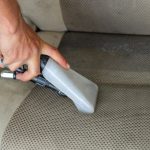Start by checking your upholstery’s fabric type and cleaning code to pick the right method. Gather supplies like a vacuum with an upholstery attachment, gentle detergent, and soft cloths. Remove cushions and vacuum thoroughly, focusing on crevices. Treat stains promptly using appropriate cleaners, blotting gently without rubbing. After cleaning, let fabric dry fully and keep cushions fluffed. Stick with these basics to keep your upholstery fresh and durable, and there’s plenty more to help you master the process.
Table of Contents
Key Takeaways
- Identify upholstery fabric type and check cleaning codes before starting to prevent damage during cleaning.
- Gather essential supplies like a vacuum with upholstery attachment, mild detergent, soft brush, and spray bottle for efficient cleaning.
- Vacuum thoroughly to remove dust and debris from all upholstery surfaces and crevices before applying any cleaner.
- Treat stains promptly by blotting spills and using appropriate cleaning solutions tested on hidden spots first.
- Maintain upholstery by regular vacuuming, rotating cushions, using protective covers, and scheduling professional cleanings as needed.
Assessing Your Upholstery Material
How do you figure out the best way to clean your upholstery? Start by identifying the fabric type—this guides your cleaning approach.
Check the manufacturer’s tag for cleaning codes: W means water-based cleaners are safe, S indicates solvent-based only, WS allows both, and X means vacuuming or professional cleaning is best.
Manufacturer tags guide cleaning: W for water-based, S for solvent-based, WS for both, X for vacuum or pro care.
If there’s no tag, test a hidden spot with a mild cleaner to see how the fabric reacts.
Also, consider the fabric’s texture and durability; delicate materials like silk or velvet need gentle care, while sturdy fabrics like microfiber handle more aggressive methods.
Understanding your upholstery’s material helps prevent damage and guarantees you choose the right techniques, saving you time and effort in the cleaning process.
Gathering the Right Cleaning Supplies
To clean your upholstery effectively, you’ll need a few essential supplies tailored to your fabric type. Gathering these items beforehand saves time and guarantees you can tackle stains and dirt efficiently.
Here are the four must-have cleaning supplies:
- Vacuum cleaner with upholstery attachment – removes dust and loose debris.
- Mild detergent or upholstery cleaner – choose one that suits your fabric.
- Soft-bristled brush or microfiber cloth – for gentle scrubbing without damage.
- Spray bottle with water – helps dilute cleaners and rinse areas as needed.
Having these on hand lets you address your upholstery’s needs confidently, guaranteeing a thorough clean without risking fabric damage.
Next, you’ll be ready to prep your furniture for the cleaning process.
Preparing Your Upholstery for Cleaning
Before diving into cleaning, you’ll want to prepare your upholstery carefully to guarantee the best results. Start by checking the manufacturer’s label for any specific cleaning instructions or warnings.
Always begin upholstery cleaning by reviewing the manufacturer’s label for essential care guidelines.
Remove all cushions, pillows, and detachable fabric parts to access every surface. Inspect the upholstery for stains, tears, or delicate areas that might need special attention or repair before cleaning.
Test your chosen cleaning solution on a small, hidden spot to verify it won’t damage or discolor the fabric. Clear the surrounding area to give yourself enough space to work comfortably.
Finally, gather all your supplies within reach. Taking these steps will set a solid foundation, making the actual cleaning process more effective and protecting your upholstery from accidental damage.
Vacuuming and Removing Loose Dirt
Start by thoroughly vacuuming your upholstery to remove dust, dirt, and debris that can embed into the fabric. This step prevents grime from settling deeper during cleaning.
Use a vacuum with an upholstery attachment for the best results. Focus on areas with heavy use and crevices where dirt accumulates.
Follow these steps:
- Remove cushions and vacuum both sides separately.
- Use a brush attachment on delicate fabrics to avoid damage.
- Pay special attention to seams, folds, and under cushions.
- Vacuum slowly to guarantee you pick up all loose particles.
Doing this regularly keeps your upholstery fresh and extends its lifespan by preventing dirt buildup before deeper cleaning.
Spot Cleaning Stains Effectively
When you spot a stain, the first step is to identify its type to choose the right cleaning solution.
You’ll want to apply a treatment that targets the specific stain without damaging your upholstery.
Let’s go over how to recognize stains and handle them effectively.
Identifying Stain Types
Recognizing the specific type of stain on your upholstery is essential for effective spot cleaning.
Different stains require unique approaches, so you’ll want to identify what you’re dealing with before you start.
Here are four common stain types to look out for:
- Organic stains – from food, drinks, or bodily fluids; these often have a color or odor.
- Oil-based stains – such as grease, makeup, or lotions; they feel slick or greasy.
- Dye stains – caused by ink, markers, or fabric dyes; these usually have strong, vivid colors.
- Tannin stains – from coffee, tea, or wine; they typically leave a brownish mark.
Choosing Cleaning Solutions
Knowing the type of stain you’re dealing with helps you pick the right cleaning solution that will tackle the spot without damaging your upholstery.
For water-based stains like coffee or juice, a mild detergent mixed with water usually works well. Oil-based stains, such as grease or makeup, need a solvent-based cleaner to break down the oils effectively.
For protein stains like blood or sweat, an enzyme cleaner is your best bet, as it breaks down the proteins. Always test your chosen solution on a hidden area first to verify it doesn’t discolor or weaken the fabric.
Avoid harsh chemicals on delicate materials, and consider using specialized upholstery cleaners designed for your fabric type. This careful selection guarantees you treat the stain effectively while preserving your furniture’s look and feel.
Applying Spot Treatment
Although spot treatment requires careful attention, you can effectively remove stains by acting quickly and using the right technique. The key is to treat the spot as soon as you notice it, preventing stains from setting into the fabric.
Follow these steps to apply spot treatment correctly:
- Blot the stain gently with a clean cloth to absorb excess liquid; avoid rubbing.
- Test your chosen cleaning solution on a hidden area to verify it won’t damage the fabric.
- Apply the solution directly to the stain, using a soft brush or cloth to work it in lightly.
- Blot again with a dry cloth to lift the stain and excess moisture, then let it air dry.
Deep Cleaning Techniques for Upholstery
When you want to restore your upholstery’s freshness beyond surface cleaning, deep cleaning techniques are essential.
Start by vacuuming thoroughly to remove loose dirt and debris. Next, choose a cleaning solution suitable for your fabric type—test it on a hidden spot first to avoid damage.
Begin with a thorough vacuum, then select and test a fabric-safe cleaner on an inconspicuous area.
Use a soft brush or cloth to gently scrub the solution into the fabric, focusing on heavily soiled areas. For stubborn stains, consider using a steam cleaner, which penetrates deep without soaking the upholstery.
Be careful not to oversaturate, as excess moisture can harm the fabric and padding. After cleaning, blot the area with a clean, dry cloth to lift dirt and moisture.
Deep cleaning refreshes your upholstery, eliminating embedded dirt and allergens you can’t reach with simple spot treatments.
Drying and Maintaining Freshness
After deep cleaning your upholstery, allowing it to dry properly is key to preventing mold and odors.
You want to speed up drying without damaging the fabric or stuffing. Here’s how to do it right:
- Open windows or doors to increase airflow and help moisture escape.
- Use fans or a dehumidifier to reduce humidity and speed drying.
- Avoid direct sunlight, which can fade colors or weaken fibers.
- Resist sitting on or using the furniture until fully dry to keep it fresh and clean.
Following these steps guarantees your upholstery dries evenly and stays fresh longer.
Proper drying protects your investment and creates a comfortable, inviting space.
Tips for Preventing Future Stains and Damage
To keep your upholstery looking great longer, you should take proactive steps to prevent stains and damage.
Start by applying a fabric protector spray suitable for your upholstery type; it creates a barrier against spills and dirt. Avoid eating or drinking on your furniture to reduce accidental stains.
Regularly vacuum your upholstery to remove dust and debris that can wear fibers down over time. Rotate cushions and pillows frequently to guarantee even wear and maintain shape.
Keep your furniture out of direct sunlight to prevent fading and fabric deterioration. Address spills immediately by blotting, not rubbing, to prevent stains from setting.
Ultimately, consider using slipcovers or throws in high-traffic areas to protect your upholstery while adding style.
These simple habits can greatly extend your furniture’s life and appearance.
Frequently Asked Questions
Can Upholstery Cleaning Remove Pet Odors Permanently?
You can’t always remove pet odors permanently with upholstery cleaning alone, but regular deep cleaning and using enzyme-based cleaners can greatly reduce smells. Consistent maintenance helps keep your furniture fresh and odor-free over time.
How Often Should Professional Upholstery Cleaning Be Done?
You should get professional upholstery cleaning every 12 to 18 months to keep your furniture fresh and hygienic. If you have pets or allergies, consider cleaning more often to prevent buildup and odors.
Are Steam Cleaners Safe for All Upholstery Types?
Steam cleaners aren’t safe for all upholstery types. You’ll want to check your fabric’s care label first. Delicate materials like silk or velvet can get damaged, so avoid steam cleaning those to keep your furniture looking great.
What Are Eco-Friendly Upholstery Cleaning Options?
You can use vinegar and water, baking soda, or gentle castile soap for eco-friendly upholstery cleaning. These natural options are safe, effective, and free from harsh chemicals, helping you keep your furniture fresh and green.
Can Upholstery Cleaning Help With Allergy Relief?
Did you know 90% of indoor allergens live in your furniture? Cleaning upholstery regularly can reduce dust mites and pet dander, helping you breathe easier and greatly easing allergy symptoms in your home environment.
- Can You Iron Nonwoven Fabric? A Safety Guide - July 11, 2025
- Exploring the Strength and Durability of Nonwoven Fabrics - July 11, 2025
- The Role of Nonwoven Geotextiles in Soil Stabilization - July 11, 2025







